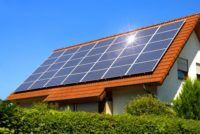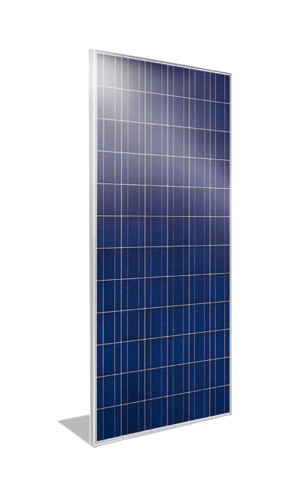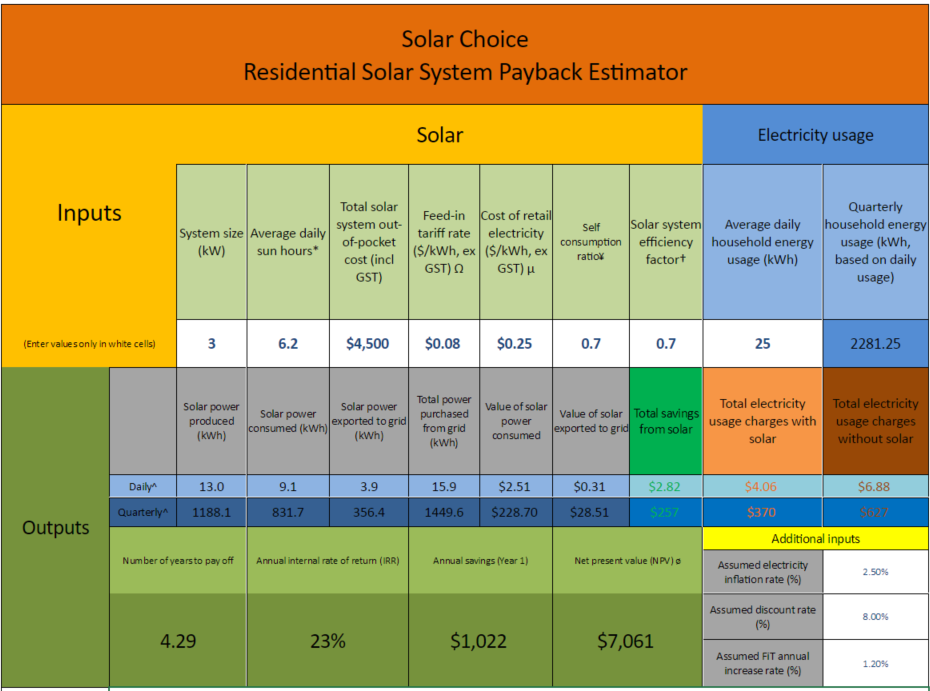Solar power is still a great investment in NSW even in the absence a feed-in tariff incentive in the state. The fact that solar PV system prices have been declining combined with the fact that retail electricity rates have risen significantly in recent years means that solar panels can now serve as a cost-effective, rooftop ‘power plant’ for NSW homes and businesses. This article takes a look at the benefits of solar power and how to best take advantage of them.
Compare solar & battery storage quotes from installers in your area!
Compare Solar & Battery Quotes
 What are the benefits of a solar power in NSW?
What are the benefits of a solar power in NSW?
The main reason that NSW homes and businesses opt to go solar is to save money on their power bills. Since the closure of NSW’s Solar Bonus Scheme to new applicants, new solar system owners stand to benefit most from having a system by aiming to consume as much of the solar power that they produce as possible known as ‘solar self-consumption‘.
Through solar self-consumption, system owners reduce the amount of electricity that they have to purchase from their electricity retailer/utility. Sending excess solar energy into the grid is more of a way to earn additional savings and to get some value from the solar energy you can’t use yourself.
Federal discount for solar PV system installation in NSW
The federal government’s Renewable Energy Target (RET) is now the primary mechanism for the subsidisation of small-scale rooftop solar in Australia. In effect, the federal government, through the RET, subsidises the installation of any solar PV system up to 100 kilowatts (kW) in capacity.
Exactly how much this federal discount works out to be depends on a few factors, including the location of the installation (sunnier regions will receive a larger discount) and the market price of the tradable certificates (small-scale technology certificates or STCs) that constitute the subsidy.
Generally speaking, in NSW this discount is in the region of 30% off the full cost of an installation. This means a discount of around $3,500 off a 5kW solar system, or $2,100 off a 3kW solar system. The subsidy is applied directly to the up-front cost of your system and should be itemised on the quote and contract from your solar installer.
Attractive return on investment (ROI) for solar power in NSW
In NSW, where there is currently no government-backed solar feed-in tariff in place, a solar power system can provide its owner savings on electricity bills by reducing the need to purchase power from the electrical grid. Additional credits can be earned for the solar energy that you send into the grid – the rate offered will depend on your retailer.
Investing in a solar power system would be particularly advantageous for those who consume the bulk of their electricity during daylight hours, but as long as you can use at least 30% of the energy that the system produces the investment case will probably look pretty good.
Learn more: Read our Quick Guide to solar system sizing or check out our Solar Payback Estimator.
Solar power is a low-maintenance investment
Rooftop solar systems generally have no moving parts and require very little in the way of maintenance or inputs once they are installed and functioning.
Tax benefits for businesses with solar power systems
ABN holders may be able to claim depreciation and GST credit on system production.
 Typical solar system size in NSW
Typical solar system size in NSW
The solar power system size best suited to your needs will depend on your daytime electricity demand. Since any solar electricity exported to the grid will earn you only a relatively small bill credit, consider installing a system that will meet your daytime electricity demand. Depending on the home or business, the best system size may be as small as 1.5kW or 10kW, or upwards of 50kW or 100kW.
Learn more: Check out our Solar System Sizing Estimator Tool
…and how much power will my solar power system produce?
Each solar power system has its own nameplate capacity, in kilowatts (kW). Real solar system output relative to this figure will ultimately depend on the quality of the components (are they functioning to specification?), the weather, and shading.
Depending on the details of their situation, system owners can expect their system to produce 3.5-4.5 kilowatt-hours (kWh) of solar energy daily, averaged across the year. For example, a 5kW solar system would produce between about 18 and 22kWh on an average sunny day.
Assuming an electricity rate of 25c/kWh, self-consumption of all this power would result in a maximum power bill savings of $4.50 and $5.50 per day – as compared to a savings of only about $1.45 for sending all the energy into the grid (for an assumed feed-in rate of 8c/kWh). With electricity rates set to continue rising significantly in the medium to long-term future, solar PV will become an increasingly effective way for system owners to protect themselves against soaring power bills.
More realistically, a home may only be able to use about 30%-60% of the energy that their system produces (we recommend that you use at least 30%). In you have a 5kW system and use 30% of the energy, you could save roughly $1.35-$1.65/day in avoided electricity bill charges plus about $1-$1.20/day in feed-in credits.
Remember that circumstances will vary: check out our Solar Payback Estimator to play with the numbers yourself.
Compare solar & battery storage quotes from installers in your area!
Compare Solar & Battery Quotes
© 2019 Solar Choice Pty Ltd (This article was originally published in 2010; it has since been updated.)
- Solar Panel Costs: Solar Choice Price Index | April 2025 - 1 April, 2025
- Solar Panels For Homes – All You Need to Know About Solar Systems - 18 March, 2025
- Best NSW Solar Feed-In Tariffs - 17 March, 2025

keep up the good work. Love reading everything
Are you aware that electrical retailers are not only putting up their rates, but are now proposing to charge solar feed in clients ! How you ask.
Well there is to be a charge fee for reading the amount of electricity you feed into the grid. This charge will vary with the sign up arrangement you determine with your retailer at the end of this year.If you sign up for one year, your rate will be 6 cents a kwh.
If you sign up for 2 years you can earn 8 cents a kwh, and if you sign up for three years you can earn up to 12 cents a kwh.
HOWEVER, wait for it, there is to be a LEVY for each level.
For 6 cent the levy is $10, for 8 cents its around $15, and for 12cents its $20. We are actually going to have to pay to have our green solar generated electrity fed into the grid !!! The government needs to step in here and stop these rip-off merchants.
Yes, Energy Australia in my state of NSW are the ones now doing this. The “levy” is a monthly fee to cover “administration” for the install of a smart meter and “sharing” with the home owner some of the information that the smart meter produces. It is just taking back in one hand what they give to you in the other with the FiT.
Its All Wrong!
Find out if your electricity supplier will fit a ‘SMART METER’ which apportions all your solar power to your residence as first priority then any excess goes to the grid at 6 cents a unit.
Origin ENERGY WILL SUPPLY THE NEW SMART METER BY 2017.
The standard existing smart meters input all solar energy to the grid which will reduce to 6 cents per unit from the end of 2016.
Check your supplier`s intentions.
Dodo are apparently not supplying the new smart meter.
I am altering my system as an on and or off grid system.
I am installing a Victron Multi Plus Inverter Charger 5000VA-4500W 48Volt 230V AC Pure Sine Wave controller.
This unit can be on or off grid with input terminals from the grid or from a generator. this sized unit can handle heavy starting loads up to ten kilowatts and gets its power from a 48 volt battery bank.
The solar array is fed through controller chargers direct to the batteries. i AM USING TWO Victron-150V-35A-MPPT-12V-48V-150-35-Solar-Charge-Controllers.
The Morningstar Tristar Solar charger is my other charger controller.
Connection of panels in my case will be pairs in series then the number of pairs will be connected in parallel to the input of the charge controllers. This system gives the best input as any shaded
panels do not affect input from other panels.
Important note: THE”VOC” (Voltage open circuit) must not exceed the charger stated maximum VOC. Check your panels then check your controller ratings.
Presently Origin energy are paying a feed in tariff of 6c, but are charging 21.94c per kw. So anyone not on the original government feed in tariff is paying 16.95c for electricity that they are producing. Consumers are paying for something that they have paid to produce.This is completely wrong on many levels.The whole system needs revamping.
Hi Paul,
We wholeheartedly agree with you that the situation is not right, and you are certainly not alone in vocalising your thoughts on the absurdity of utilities paying out only nominal sums for excess solar power (and basically pocketing the difference). Despite this, it’s still worth it to go solar for many homes and businesses – as long as they are smart about how they do it.
This is why we always recommend that anyone thinking about going solar in Australia get a system that is appropriately sized for their daytime electricity needs, and that they use as much of their solar power as they can by maximising their daytime electricity consumption.
We’ve actually published a 2-part series titled “How to get the most out of your solar system“. It’s essential reading for anyone thinking about going solar in Australia.
Please have a look and share it around! In the meantime we’ll hope that utilities start offering fair market value for excess solar power from homes & businesses. As more and more homes start going off-grid, they’re likely to get the message.